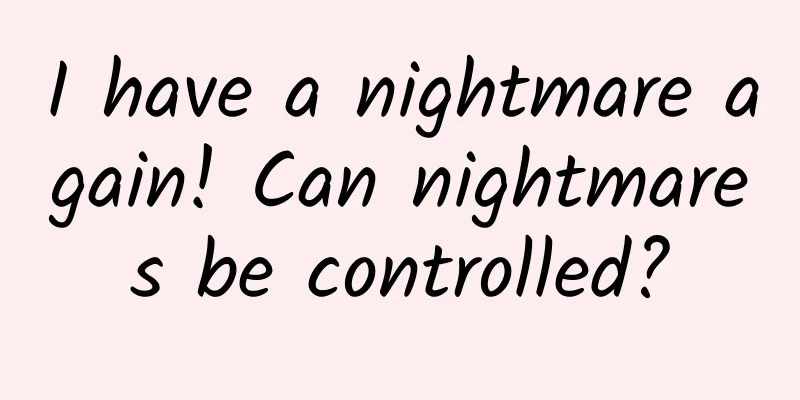I have a nightmare again! Can nightmares be controlled?

|
Leviathan Press: Some studies have pointed out that nightmares are caused by transient ischemic attacks (TIA) during sleep. This theory holds that when a person suffers a transient ischemic attack while awake or asleep, mild symptoms may only include dizziness, palpitations, chest tightness, black eyes, and various mild neurological disorders, while severe symptoms may include sweating, pale face, dilated pupils, and even shock. Of course, there are many external factors that induce nightmares, such as mental stress, improper medication, etc., which are also potential factors for nightmares. However, the lucid dream therapy (LDT) mentioned in the article does have a certain degree of persuasiveness. After all, it can make people who have nightmares realize that they are just dreaming, which is of extraordinary significance. During Japan’s stormy summer of 1983, Ikuo Ishiyama couldn’t stop thinking about a creepy phenomenon. These were his patients, dead, but that wasn’t what bothered him. As a forensic expert at the University of Tokyo, Ishiyama was used to seeing corpses. Yet, these hundreds of victims had similar causes of death. “The symptoms were all the same,” he told the Los Angeles Times. “These were young people with no health problems, and they all died in the same way, almost without any signs.” How? This might be the most mysterious detail: All of the victims died in their sleep. Shishan's concerns deepened when he learned that similar deaths were occurring halfway around the world in the American Midwest. There, the phenomenon was called "nocturnal death syndrome," but the circumstances were just as disturbing. As science journalist Alice Robb wrote in her book Why We Dream, "They died in the early hours of the morning, lying on their backs, with terror in their eyes." To this day, the exact cause of these deaths remains a mystery. But an anthropologist working at the University of Arizona, who has spent a decade studying the phenomenon, believes that the victims may have suffered cardiac arrest due to "stress, physiological reactions, and sheer fear." Were they killed by nightmares? Harvard Medical School estimates that up to 7% of the US population suffers from severe nightmares. © vandervelden /Getty Images Word of the phenomenon spread, causing panic across the American interior. Eventually, word reached Wes Craven, a psychology graduate from Ohio State. The story inspired Craven to create a whole new kind of villain in his 1984 horror film A Nightmare on Elm Street—a demon who killed his victims in their dreams. Contrary to what my mischievous older brothers said, Freddy Krueger was not real. But the health crisis that inspired the character showed that nightmares do pose a real physical and mental threat. And just because Freddy is fictional doesn’t mean nightmares are harmless. “I don’t see any contradiction between being pragmatic and believing that dreams do have very real effects on our lives and our physical and mental health,” Rob told me over the phone. “We know that nightmares can have physiological effects on us—heart rate increases, sweating, right? Nightmares do disrupt our sleep quality, which obviously has knock-on effects on all the systems in our body.” According to the Diagnostic and Statistical Manual of Mental Disorders (DSM), nightmares that are severe enough to cause symptoms such as insomnia, stress, anxiety, and cognitive impairment are called “nighttime sleep disorders.” Harvard Medical School estimates that up to 7% of the U.S. population suffers from severe nightmares[1]. For children, that rate can be as high as 20 percent. (I should caution at this point that if you think you’re suffering from sleep-related health issues, consult a doctor or mental health professional rather than reading an article that begins with A Nightmare on Elm Street.) But for most of us, nightmares are a common phenomenon that haunts us, triggers sleepless nights, and continually infringes on our sense of well-being. What makes nightmares so terrifying isn’t the monsters that populate them, but the phenomenon itself. They’re controlled by our minds, and the mind’s capacity for fear is essentially endless. Nightmares are unpredictable, they relentlessly prey on our weaknesses; who knows how to scare us better than our subconscious mind? But the worst part is that in nightmares we are passive victims. Or is that really the case? In recent years, a small group of dedicated researchers, neuroscientists, sleep coaches, and dreamers around the world have begun to explore how to use a set of specific sleep skills to regain control of our consciousness during sleep and fight against the "monsters" that torment us. In other words, they are learning how to fight nightmares. While writing her book, Rob found herself walking through the doorways of a medieval monastery in a remote part of the Netherlands. The doorways had been borrowed by the International Association for the Study of Dreams for its annual conference, so she didn’t see any medieval monks. Monks or not, the Gothic monastery was a fitting place to study the science of lucid dreaming, which has only recently emerged from the Dark Ages. Westerners had been writing about lucid dreaming as far back as Aristotle, but lucid dreaming—being aware that you’re dreaming—was not taken seriously by the medical community until the 1970s. © Tumblr One reason is that sleep itself remains one of the least understood processes in the human body in medicine. Rapid eye movement (REM) sleep, when most dreaming occurs, was not discovered until 1953. It wasn’t until the late 1980s that researcher Stephen LaBerge demonstrated the existence of lucid dreams, using a clever and simple method: during REM sleep, our bodies are essentially paralyzed, with the exception of our eyes. Using this eye activity loophole, LaBerge hooked himself up to a scanner, entered REM sleep, and, while physiologically unconscious, performed predetermined eye movements in his lucid dreams for scientists to observe. The experiment demonstrated that he was able to control his behavior while in full REM sleep.[2] Can you really fight your demons on a physical level? Despite its proven existence, lucid dreaming remains, as science writer Tom Chivers put it in The Sunday Times in 2019, "…a subject studied with a touch of mild irony, mostly by people who believe in UFOs and psychics." This skepticism may also reflect the relative rarity of lucid dreams. Only around 10% of people experience them regularly. If we can gain a deeper understanding of lucid dreams, sleep, and the workings of our brains as a whole, it could help bring more people into a state of mastery over their dreams and conquering nightmares. "If you can become lucid in a nightmare, you can change your response or do things in real time that enhance your ability to cope, which could improve your ability to cope with it," Denholm Aspy, a psychology researcher at the University of Adelaide, told the BBC. Research supports this idea. In 2003, a preliminary study authored by Victor Spoormaker of the Max Planck Institute of Psychiatry found that lucid dream therapy (LDT) was "effective in reducing nightmare frequency" and concluded that "a single two-hour LDT session resulted in a small but significant reduction in nightmares." [3] © Noam Galai/Getty Images But how do we actually learn to face nightmares? There are many ways to cope, from simply realizing that we are dreaming and therefore feeling less scared, to running away from the demons created by our subconscious mind, or even confronting them head-on. To me, this sounds too good to be true (and too cool to be true). Can you really fight your "demons" on a physical level? Okay, not "physically", but you get my drift. What better place to learn how to cope with dreams than in Freud's native Austria? Brigitte Holzinger, a psychotherapist at the Medical University of Vienna, explained to me that one of the most crucial steps in conquering nightmares is to understand them in the first place. "It is very important for the patient to understand what we are doing, what is happening when we dream and what the dream is about. We are raised to believe that dreams don’t have much to do with us, that we can’t influence them. But that’s not true. In fact, dreams are our internal images. Therefore, we can influence them. We have the power to influence dreams, and we influence them all the time. ” Holsinger, who founded the Sleep Coach Academy in Austria, details the classes she teaches her patients to turn them into neurological nightmare warriors (my wording, obviously), or at least get a good night’s sleep. “I make my patients realize that what we are talking about now has an impact on their dreams,” she says. “We are actually fighting nightmares just by talking about it.” My god, I did it effortlessly. These first steps were not just to boost my confidence. Simply increasing your daily awareness is an essential tool for achieving lucid dreams. A 2003 study from the Max Planck Institute used a similar technique, asking volunteers to "try to maintain self-awareness during their next nightmare." Participants were encouraged to choose a constructive ending, also known as a 'victorious ending' (such as talking to or confronting the attacker, rather than running away). A victorious ending. Finally someone has described it in those semi-mythical terms I love. Another similar technique suggests pausing at any time during the day to ask yourself if you're dreaming. Ideally, questioning your reality will become such a natural part of your behavior that you'll do it in real dreams, too—but then the answer will be, "Oh my god, I'm dreaming!" Are we doomed to be passive victims of our nightmare? Or can we fight back? © Christophel/Alamy These steps are all part of the concept of awareness. Holsinger gives the example of having her students keep a dream journal. I asked her how journaling can be effective in changing dreams, since dreams are over. “By keeping a dream journal, you’re sending a signal to yourself: ‘This is important to me,’ ” she said. The goal is to find opportunities to connect our waking lives to our dreams. “Because it’s not just about the before and the after,” she explained. “It’s always with us.” Awareness of dreams is all well and good, but how can you use it to, say, send Freddy Krueger back to Hell? A 2019 study published in Frontiers in Science reviewed various nightmare control techniques that date back to 1982.[4] One, called imagery rehearsal therapy, encourages patients to rehearse different endings to their nightmares while awake, with the goal of having the subconscious mind automatically change what happens in the dream. Once you’re in the lucid state of the nightmare, you can “confront the source of your fear, such as a monster,” the Frontiers paper states. This strategy suggests that simply confronting the monster with the awareness that it can’t hurt you can end the nightmare. These techniques have had remarkable results. A 2006 study found that LDT helped reduce nightmare frequency by more than 15%: "They practiced rewriting their dreams, creating new endings within them that allowed them to regain control and avoid the usual horror scenarios." Writer Mason Currey described his own experience using these skills in Slate magazine, including escaping from two pursuers by flying into the air in a dream (a common theme in nightmares). [5] With lucid dream therapy (LDT), you can fight or flee (sometimes literally) from your nightmares. © Glasshouse Images/Getty Images Rob also offers a case study of a writer who had the same recurring nightmare: a stranger stood outside his window, threatening to kill him. "After a few minutes of extreme panic, the stranger would break into the house and start beating him." Eventually, the intruder brought a gun. However, the writer was able to change his perspective. "As the man started shooting," Rob says, the writer "realized that the bullets weren't hurting him. It was just a dream. The nightmare never came back." "The plot of the nightmare has changed." I enjoyed hearing about these battles with imaginary monsters, but LDT also involves confronting demons that are more personal, more terrifying, and ultimately more real. In a 2021 study, Holsinger shared a heartbreaking example of a woman called “Ms. L.” Ms. L had “been traumatized multiple times throughout her life.” She had been abused as a child, and later, after an unhappy marriage, her ex-husband stalked and threatened her, holding a gun to her head and demanding that she return to him. Ms. L eventually escaped her ex-husband, but soon after, she began having terrifying nightmares, “multiple times a week of her ex-husband stalking and threatening her.” Holsinger’s team and other patients in group therapy helped Ms. L develop strategies she could use to cope with her nightmares after she woke up. They advised her to try to “look what was happening straight in the face,” to examine the “monster” itself. After multiple unsuccessful confrontations, Ms. L wrote in her journal on March 3, 2009: "My ex-husband chased me into a taxi. This time he had a very large gun in his hand. He shouted that he would kill me with a sadistic smile. I shouted back to let him come. I ran towards a downhill slope and he stumbled and fell down the hill. I looked but I could not see him anymore. Both the taxi and him disappeared. When I woke up, I was no longer afraid this time, but felt a sense of relief that I had never felt before." During this time, Ms. L. did not become a nightmare warrior. The nightmares did not stop, but the outcome was no longer beyond her control. As Holsinger put it, “The plot of the nightmare changed.” These results are incredible, but there’s still a lot more to learn about LDT. After all, nightmares themselves are still full of mysteries. Even now, Holsinger is working to understand how dreams are affected by external stimuli. (Did you know that when your bedroom is cold, you feel cold in your dreams? Science still doesn’t fully understand this phenomenon.) In the meantime, nightmares still plague us. Maybe not to the extent that Ishiyama fears, and certainly not to the extent that Freddy Krueger would like, but it’s still a real problem. At the end of our call, Rob told me that she was surprised by the breadth of the problem while writing her book. “I was really shocked to find out how many people have very intense dream lives, including nightmares that affect them deeply. I mean, you can say something is ‘just a dream,’ but it still happened. It still affects you. You experience fear in the moment, and sometimes that fear even extends into the day.” Fortunately, as Holsinger reminded me, while our own brains may be the source of fear, they are also the key to overcoming it. “My goal is to help my clients realize that they always have a choice, and it’s their choice what to do. It’s so important to realize that you have choices, especially when you feel powerless.” Her and her colleagues’ ongoing explorations may help us regain control of that power (or the power of our brains). By Pat Cassels Translated by gross Proofreading/tamiya2 Original article/www.atlasobscura.com/articles/how-to-fight-your-nightmares This article is based on the Creative Commons License (BY-NC) and is published by gross on Leviathan The article only reflects the author's views and does not necessarily represent the position of Leviathan |
>>: How much color will enter the body after tattooing? This explanation is surprising →
Recommend
10 major channels tell you how to do a good job in APP overseas promotion!
Channel 1: Search Engine Promotion There are many...
How to operate a community? Information density is key!
The vast majority of communities are content prod...
How much does it cost to be an agent of Kashgar Homestay Mini Program? What is the quote for Kashgar B&B mini program agent?
How much does it cost to be an agent for the Kash...
Overseas Promotion: How to promote and attract fans on YouTube?
Because of my work, I currently have the opportun...
Not all sharks are so vicious!
Key Points ★ Even great white sharks don’t like t...
Accenture: The Art of AI Maturity
While the majority of businesses using artificial...
"Hitting a tree can improve your health"? Wrong! Be careful of serious problems
In the park in the morning Have you ever seen suc...
In a red ocean market with no resource advantages, how did NetEase Cloud Music achieve 300 million users?
In a situation where music player apps are in a c...
How to plan an efficient marketing operation plan?
In recent years, mobile Internet has developed ra...
Is it effective to eat Cordyceps sinensis as a tonic in winter? Can I choose to cut the grass?
It is the right time to take tonic in winter. As ...
Analysis of major mainstream information flow promotion channels in 2019!
With the development of social media, information...
Dinosaurs once lived in Fujian! Return to the Cretaceous and dance with the dragons
In November 2020, more than 240 Late Cretaceous d...
Build a live broadcast operation system from 0 to 1!
More and more To B companies are starting to do l...
Is it necessary to build a WeChat mini program mall?
According to the 2019 WeChat data report, the num...
Mobike, why do you occupy other people's parking spaces?
Mobike, one of the biggest highlights of which is...









